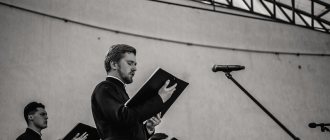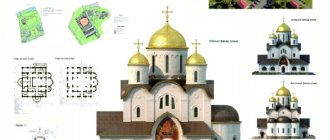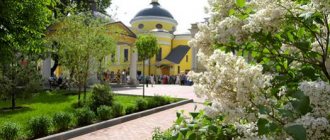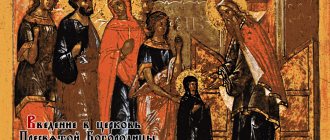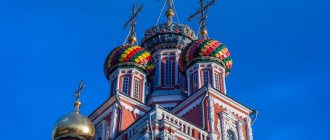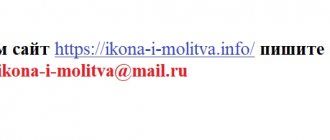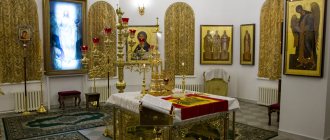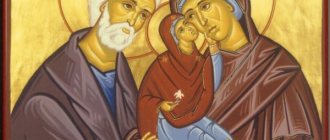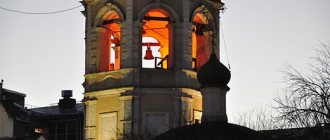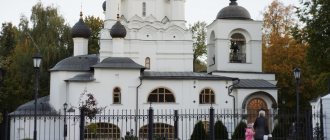| Presentation of the Blessed Virgin Mary into the temple, icon. |
Presentation of the Blessed Virgin Mary into the Temple
(Greek: Eisodos tes Hyperagias Teotokou en to; Latin: Praesentatio S. Mariae in templo), one of the great church holidays, dedicated to the event of the bringing of the Blessed Virgin Mary by Her parents to the Jerusalem Temple for dedication to God. The celebration takes place on November 21.
The Event of the Introduction is not mentioned in the canonical Gospels and is known from later apocryphal texts (Greek “Proto-Gospel of James” (chap. 7.2-3) (2nd half century), Lat. Gospel of Pseudo-Matthew (c.)), which reflect oral tradition, but are supplemented with details from biblical books of educational significance (1 Chron. 15 and Ps. 44), as well as from the gospel story of the Presentation (Lk. 2. 22–38).
According to the mentioned sources, the parents of the Most Holy Theotokos Joachim and Anna, when their Daughter reached the age of 3, decided to fulfill the vow they had previously made, dedicate Her to God, and headed to the Jerusalem Temple. Near the entrance to the temple stood young virgins called by Joachim with lit lamps, so that young Mary would love the temple with all her heart. The Blessed Virgin, despite Her age, easily overcame the steep steps of the temple and was met and blessed by the high priest, according to legend, Zechariah, the father of John the Baptist. By a special revelation, She, as an animated ark of God (cf. 1 Chron. 15), was introduced into the Holy of Holies, where only the high priest had the right to enter once a year (see: Ex. 30. 10; Heb. 9. 7) - by this Her special role in the fate of humanity was revealed. The Event of the Introduction marked the beginning of a new stage in the life of the Immaculate Virgin - a stay at the Jerusalem Temple, which lasted until She was 12 years old. Living at the temple, Mary devoted herself to prayer, study of the Holy Scriptures and handicrafts. As time passed, She, who decided to preserve her virginity and be ignorant of God, was, in order not to violate her father’s traditions, entrusted to the care of Joseph the Betrothed.
What is the Presentation of the Blessed Virgin Mary into the Temple?
The Entry into the Temple of Our Most Holy Lady Theotokos and Ever-Virgin Mary is the full name of the holiday that the Russian Orthodox Church celebrates on December 4 (new style). This is the second twelfth feast of the Mother of God of the church year. The twelfths are holidays that are dogmatically closely connected with the events of the earthly life of the Lord Jesus Christ and the Mother of God and are divided into the Lord's (dedicated to the Lord Jesus Christ) and the Theotokos (dedicated to the Mother of God).
On this day, Orthodox Christians remember how the holy righteous Joachim and Anna brought their three-year-old daughter, the Most Holy Theotokos, to the Jerusalem Temple. They did this to fulfill their vow before the Lord - to dedicate their daughter to His service. From that day on, the Virgin Mary lived at the Jerusalem Temple - until the very moment she was betrothed to the righteous Joseph.
We will not find mention of the events of this holiday in the canonical Gospels, but Church Tradition (which is revered on a par with Holy Scripture) tells us about it. Namely - “The History of Jacob about the Birth of Mary”, or “Proto-Gospel of Jacob” (II century), and “The Gospel of Pseudo-Matthew” (the Latin version of the childhood of the Virgin Mary and Jesus, which developed by the 9th-10th centuries, but based on earlier “ Gospels of Childhood").
Liturgical regulations
Feast of the Entry into the Temple of the Blessed Virgin Mary according to the Typikon of the Great Church (IX–X centuries)
In the early manuscript of this Typikon [12] there are no special instructions regarding the order of the service for the Introduction, only the memory of the event is noted [13], the same was found in the Canonar [14]. According to 2 manuscripts - centuries, the service for the Entry was sung in the Church of the Most Holy Theotokos in Chalcopratia (the usual place, along with the Blachernae Church, for services on the feasts of the Mother of God), where on the morning of the day of the holiday a lithium was sent from the Church of St. Sophia with the participation of the Patriarch. At Matins (on Ps. 50), and at the small entrance of the liturgy, they sang the troparion of the 4th tone, “On the day of God’s favor the transfiguration” [15]; readings at the liturgy: prokeimenon 3rd tone (Luke 1.46a–47), Heb. 9. 1–7, alleluia (4th plagal, i.e. 8th, tone), Lk 1. 39–50, 56; involved - Ps. 115.4 [16].
In studio Typicons
, used in Byzantium until the beginning. XIII century, and in Rus' until the beginning. c., the holiday cycle of the Introduction already consists of 3 or 4 days: the pre-celebration on November 20, the holiday itself on November 21, the post-celebration on November 22 (or 22–23). Various editions of the Studite Charter - Studite-Alexievsky 1034 (reflects the Constantinople practice of the 1st half of the century), Evergetid (the practice of Constantinople monasticism in the late century), George Mtatsmindeli (the practice of Athonite monasticism in the middle century), Messinian 1131 . (South Italian (Calabro-Sicilian) practice of the 12th century) Typicons set out the order of services of the introduced cycle with some differences [17].
In the earlier Studian-Alexievsky, as well as the southern Italian Messinian and Nikolo-Kazolian Typikons and Studian Menaions - XII centuries. [18] the after-feast is 1 day; in the Evergetid and George Mtatsmindeli Typikons – 2. Typikon of the Grottaferrata Monastery [19], late southern Italian. the studio Typikon extends the post-celebration for 3 days [20]. The day of the Feast of Introduction is not highlighted in the studio Typicons.
On the day of the forefeast, November 20, a service is performed with “God is the Lord”; the sequence of the Introduction is combined with the sequence of the saints of this day. The Studios-Alexievsky Typikon for November 20 does not mention the memory of saints, however, when describing the service, the connection of the sequence of the Introduction with the sequence of the “day saint” is noted. Other Typicons indicate the memory of St. Gregory Decapolite and St. Proclus, but the service of the Introduction is connected only with the succession of St. Gregory (the same in the Studite Menaions – 12th century). Only the Evergetid Typikon provides a combination of the sequences of the Introduction and both saints and does not indicate the hymns of the Octoechos (probably due to the excess of sequences).
On the day of the Entry into the Temple of the Most Holy Theotokos, festive vespers (with entrance and 3 paremias) and matins are performed; at Matins after kathisma or festive antiphons - the 1st power antiphon of the 4th tone (“From my youth”), the prokeimenon and the Gospel of the Virgin Mary; at the liturgy - the service of the Mother of God. Only holiday songs are sung.
On the days of the post-feast, the sequence of the Entry into the Temple of the Most Holy Theotokos is combined with the sequence of the “day saint”, the canon of Matins is the same as on the day of the holiday, the stichera in some Typikons are borrowed from the sequence of November 21, in others - special ones (post-feast). The distribution of stichera, sedals and canons by day and within the days of the holiday cycle varies among different studio Typicons, although in general they are all based on the same corpus of chants.
On each of the 3 days of the holiday (November 20–22), the Studios-Alexievsky Typikon gives a special troparion: on November 20, the troparion of the 1st tone “To the righteous the fruit of Joachim and Anna is offered to God” (currently on November 21); November 21 - the same troparion as in the Typikon of the Great Church and in later liturgical books; November 22 – troparion of the 4th tone “Revere in the church in the Holy of Holies” (not used in modern books). According to the Evergetid and Messinian Typicons, on the days of the post-feast the same troparion is sung as on the 1st day of the holiday.
Various Studio Typicons set out in different ways the features of the service of the Entry of the Most Holy Theotokos into the Temple, which is mainly due to the peculiarities of one or another edition of the Studio Charter:
1) according to the Studios-Alexievsky Typikon, at vespers on the eve of the holiday, the 1st glory of the 1st kathisma “Blessed is the man” is sung, according to the Evergetid and Messinian vespers, vespers are abolished;
2) according to the Evergetid Typikon, after Vespers, pannikhis is performed (pannyksis - a special night service), at which the canons of the day and the holiday are sung (4th tone, creation of Joseph; this canon in other Studite Typikons is indicated at Matins on November 20);
3) the kathismas at Matins according to the Messinian and St. George Mtatsmindeli Typikons are replaced, as on other holidays, by 3 festive antiphons, and the Evergetid Typikon, after the kathismas and sedals, indicates the 6th kathisma to be versified (Ps. 37-45; the versification is assigned, perhaps, for this purpose , to sound Psalm 44, which is usually interpreted as prophesying about the Mother of God), and then the polyeleos;
4) since, according to the Studios-Alexievsky Typikon, Matins ends with a great doxology in the cathedral version only on Great Saturday, on the Entry of the Most Holy Theotokos into the Temple, Matins has stichera on the stichera; according to other studio Typicons, the end of Matins with the singing of the Great Doxology in the cathedral edition;
5) at the liturgy according to the Messinian and St. George Mtatsmindeli Typikons, the antiphons “There is Good”, according to the Studios-Alexievsky and Evergetidsky - figurative; The Evergetian Typikon indicates the entrance verse (Ps. 44. 15b).
In addition to the usual order of service, the Evergetid Typikon gives instructions on the coincidence of the days of the introduced cycle with Sunday - brief for November 20, 22 and 23 (only about the liturgy), detailed for November 21 (at Matins there is no polyeleos, sedate voice antiphons, prokeimenon and the Sunday Gospel are sung , the Gospel of the holiday is canceled; the entrance verse at the liturgy is canceled).
According to the Jerusalem Charter
, on which in the XII–XIII centuries. the Greeks crossed over. Churches, in the 14th century - South Slav., in the end. XIV – beginning c. – Russian Orthodox Church, the celebration of the Entry into the Temple of the Most Holy Theotokos forms a 6-day cycle: the forefeast is still 1 day (November 20), when 3 successions are sung: forefeasts, St. Gregory and St. Procla; the post-feast was increased to 4 days, including the celebration on the last day (November 22–25). With regard to the service of the Entry into the Temple of the Most Holy Theotokos, the various editions of the Jerusalem Rule differ slightly.
The service of the forefeast as a whole corresponds to the sixfold one (see Art. Signs of the holidays of the month); The follow-up contains the original troparion and several self-consents. In the old printed Russian Typicons [21], the day of the forefeast has a sixfold sign; in the Typikon currently adopted in the Russian Orthodox Church there is no sign, although the statutory instructions are almost no different from the instructions in old printed books. The troparion of the pre-celebration is different from that in the Studio Typicons. The hymns of the Octoechos are not used at the service, which is recorded in both the old printed and modern Typikons; in the latter, the hymns of the Octoechos on forefeasts are regularly abolished, and in the old printed Typikons the Octoechos are not sung due to the need to combine 3 menain sequences at once. At the evening verse, instead of the stichera of Octoechos, the stichera of St. Prokla, not sung on “Lord, I cried” (where the stichera of the forefeast and St. Gregory were sung). Matins ends according to the everyday rite, figurative antiphons are sung at the liturgy, songs of the 3rd and 6th canons of the forefeast are sung at the blessed, readings at the liturgy are ordinary and St. Prokla. The theme of the Entry of the Most Holy Theotokos into the Temple appears in the divine service long before the holiday - on November 8, the sticheron “Today is the temple of the Mother of God that can accommodate God” is indicated at the litia.
The day of the holiday, November 21, is celebrated with an all-night vigil, although the possibility of performing a polyeleos service is also stipulated. Until 2nd half. XVII century The vigil was served only in churches dedicated to the Entry into the Temple of the Most Holy Theotokos; there were no vigils at other times [22]. The Divine Service for the Introduction consists of Little Vespers, All-Night Vigil (with litia), hours and liturgy. The charter of the service is practically no different from the charter of the other twelve feasts of the Theotokos (Nativity of the Virgin Mary and Dormition). Only holiday songs are sung. At Matins according to Ps. 50 for “Glory:”, “And now” - special choruses (“Today is an animated temple”). After each song of the Matins canon, the irmos of the 1st canon of the Nativity of Christ are used as a katavasiya; from the day of the Entry into the Temple of the Most Holy Theotokos, the Christmas chaos begins, and from that time on, the services on some days of November and December have features of the pre-festival of Christmas. On the 9th song of the canon, instead of the songs of the Most Holy Theotokos and rights. Zechariah - special choruses of magnification; in modern liturgical books a total of 10 choruses are indicated (7 for the 1st canon, 1 for the 2nd and one each instead of “Glory:”, “And now”); 1st chorus of the 4th voice (“Angels enter…”) was written out already in the Annunciation kontakhar of the 12th century; in later manuscripts there are extensive cycles of refrains and magnifications [23]; in old printed Russian Typicons and Menaions only 2 choruses are indicated (1 for each canon). A feature of Russian old-printed Typikons, which is absent in modern ones, is that after the chaos of the 9th canon, the irmos of the 1st canon of the Entry of the Most Holy Theotokos into the Temple is additionally sung (and a prostration is performed). At the liturgy, as on other Mother of God feasts, figurative antiphons are performed, at the blessed - the 3rd and 6th songs of the canon of the holiday (3rd song from the 1st canon, 6th from the 2nd).
The charter of post-feast services does not differ significantly from the post-celebration services of other holidays. Chants are sung both from the 1st day of the holiday (alternately, by day, one of the two canons; samoglasny), and their own chants of the days after the feast. On November 23, the observance of the holiday can be combined with the observance of the Blgv. book Alexander Nevsky, there is no charter of service in the modern Typikon; This charter was written out in the old printed Typicons [24].
On the day of the Presentation of the Most Holy Theotokos into the Temple, November 25, the sequence of the Introduction is combined with the sequences of the schmch. Clement of Rome and Peter of Alexandria, which is a distinctive feature of the presentation of the Introduction in comparison with others, because Usually on such days the “day saints” are not sung. Otherwise, the service of giving does not differ from others: the chants of the holiday are repeated from the 1st day, only there is no entrance at Vespers with paremias and polyeleos at Matins. At the end of Matins a great doxology is sung.
Markov chapters
The typicon, currently adopted in the Russian Church, within the framework of the cycle of the Entry into the Temple of the Most Holy Theotokos, has several chapters of Mark, describing the connection with the Sunday service of the forefeast [25], feast [26], afterfeast [27] and giving [28]. If a post-celebration or dedication coincides with a Sunday, the service of one of the saints is abandoned (November 20 - St. Proclus, November 25 - Saint Peter). The other 2 chapters have generally the same content as similar chapters for other holidays.
Modern Greek parish Typikon
Protopsalt George Violakis [29] prescribes the performance of the polyeleos service without lithium (there is no all-night vigil). The order of the festive service remains approximately the same as in the modern Russian Typikon. Differences: at “Lord, I cried” the stichera are sung at 6, at the end of Vespers the troparion of the holiday is sung three times, after the polyeleos at Matins the chosen psalm “I will vomit out my heart the good word” is sung (it is used on all the twelve feasts of the Theotokos). At the liturgy there are festive antiphons, at the entrance “Come, let us worship... in the saints, wondrous…” is sung. The Typikon contains 2 chapters - about the connection with the Sunday service following the holiday and about the Sunday after the holiday (with the after-feast). If November 21st happens to be a Sunday, the choruses for the 9th canto and the antiphons at the liturgy are still sung.
Events of the Presentation of the Blessed Virgin Mary into the Temple
When the Virgin Mary was three years old, her righteous parents Joachim and Anna realized that the time had come to fulfill the vow they had made to God. Namely, to dedicate the daughter to His service. They brought Mary to the walls of the Jerusalem Temple. As the Holy Tradition says, the Mother of God easily climbed the steep steps, despite the fact that she was just a baby. The high priest was already waiting for her upstairs to bless her. According to some sources, this was Saint Zechariah, the future father of the prophet John the Baptist.
Zechariah had a revelation from the Lord, and he led Mary into the Holy of Holies - a place where only the high priest was allowed to enter, and even then only once a year. From this moment, unusual for contemporaries, the long, glorious and difficult road of the Mother of God began.
Years passed, the Mother of God lived and served at the Temple. She spent her days in prayer, studying the Holy Scriptures - right up to the moment when she was betrothed to the righteous Joseph.
Description and meaning
The significance of this holiday is great for Orthodox Christians. This day, when Mary entered the true path prepared for serving God, became the beginning of the possible appearance of Jesus Christ. According to the Orthodox, he saved all of humanity. The face of the Mother of God became an image of intercession, love for the Lord, children, relatives and friends. Became a symbol of patience, wisdom and piety.
History of the celebration of the Entry into the Temple of the Blessed Virgin Mary
As Church Tradition says, the feast of the Entry into the Temple of the Blessed Virgin Mary was known already in the first centuries of Christianity. Empress Helen Equal to the Apostles (years of life: 250-330) built a temple in honor of the Entry into the Temple of the Most Holy Theotokos. And in the 4th century, St. Gregory of Nyssa wrote about the holiday.
The Feast of the Entry into the Temple of the Blessed Virgin Mary became widespread only in the 9th century. George of Nicomedia and Joseph of Songwriting wrote two canons for the service of this day.
Iconography of the Presentation of the Blessed Virgin Mary into the Temple
On the icons dedicated to the events of the Entry into the Temple of the Most Holy Theotokos, the Mother of God herself is depicted in the center of the composition. She is wearing a maforiya, the traditional clothing of married women. Standing nearby are the holy righteous Joachim and Anna - the parents who brought her to the Jerusalem Temple.
The temple itself is most often depicted as a ciborium (a tent, a canopy over the throne). The priest Zechariah, the future father of the prophet John the Baptist, meets the Virgin Mary. Also on the icon we see a staircase of fifteen steps - according to Tradition, the three-year-old Mother of God climbed them on her own, without the help of adults.
Prayer for the Entry into the Temple of the Blessed Virgin Mary
Troparion of the Entry into the Temple of the Blessed Virgin Mary
voice 4 On the day of God's favor, the transfiguration and salvation of men is preached: in the temple of God the Virgin clearly appears and announces Christ to everyone. To that we too will loudly cry out: Rejoice, fulfillment of the Creator’s vision.
Translation:
Now is the forerunner of God’s favor and the foretelling of the salvation of people: the Virgin solemnly appears in the temple of God and announces Christ to everyone; To her we too will loudly exclaim: “Rejoice, fulfilling the Creator’s providence for us.”
Kontakion of the Presentation of the Blessed Virgin Mary into the Temple
voice 4 The Most Pure Temple of the Savior, the precious palace and the Virgin, the sacred treasure of the glory of God, is today introduced into the house of the Lord, leading grace, even in the Divine Spirit, even as the Angels of God sing: This is the village of Heaven.
Translation:
The purest temple of the Savior, the valuable palace and the Virgin, the sacred treasure of the glory of God, is now being introduced into the house of the Lord, bringing with Him the grace of the Divine Spirit; The Angels of God sing about her: “She is a heavenly dwelling.”
The Majesty of the Entry into the Temple of the Most Holy Theotokos We magnify thee, Most Holy Virgin, God-chosen Youth, and honor Thy entry into the Temple of the Lord.
Translation:
We magnify You, Most Holy Virgin, God-chosen Youth, and honor Your entrance into the temple of the Lord.
Prayer
Prayer for the Entry into the Temple of the Most Holy Theotokos
O Most Holy Virgin, Queen of heaven and earth, before the ages the chosen Bride of God, who in recent times came to the lawful temple to betrothal to the heavenly Bridegroom! You left Your people and Your father’s house in order to offer Yourself a pure and immaculate sacrifice to God, and You were the first to take a vow of perpetual virginity. Grant us also to keep ourselves in chastity and purity and in the passion of God all the days of our lives, so that we may be temples of the Holy Spirit, and especially help everyone who, in imitation of Yours, lives in the monasteries and who have betrothed themselves to the service of God, to lead their lives in the purity of virginity and from youth to bear the good and easy yoke of Christ, holyly keeping one’s vows. You spent, O All-Pure One, all the days of Your youth in the temple of the Lord, far from the temptations of this world, in constant vigil in prayer and in all mental and physical abstinence, so help us to repel all the temptations of the enemy from the flesh, the world and the devil that come upon us from our youth, and overcome it through prayer and fasting. You, in the temple of the Lord with the angels abiding, have been adorned with all the virtues, especially with humility, purity and love, and you have been brought up worthily, so that you will be ready to accommodate the incontainable Word of God in your flesh. Grant us, too, possessed by pride, intemperance and laziness, to be clothed in all spiritual perfection, so that each of us, with Your help, may prepare from us the wedding robe of our souls and the oil of good deeds, so that we may appear, without naz and unprepared, to meet our immortal Bridegroom and Thy Son, Christ. , Our Savior and God, but may He receive us with the wise virgins in the abode of paradise, where, with all the saints, grant us to glorify and glorify the all-holy name of the Father and the Son and the Holy Spirit and Your merciful intercession always, now and ever, and unto the ages of ages. Amen.
Saint Gregory Palamas. Sermon on the Entry of the Most Holy Theotokos into the Temple
If “a tree is known by its fruit”, and “a good tree produces good fruit” (Matt. 7:17; Luke 6:44), then how could the Mother of Goodness Itself and the Parent of Eternal Beauty not be incomparably more excellent than every good thing found? in the natural and supernatural world? For the Coeternal and Immutable Image of the goodness of the Most High Father, the Eternal, Pre-existing and Most Good Word, out of indescribable love for mankind and compassion for us, desired to take upon Himself our image, in order to recall our nature to Himself from the lowest hell, in order to renew this decayed nature and elevate it to heavenly heights - for all this he finds the kindest Servant, the Ever-Virgin, Whom we glorify and whose miraculous Entry into the temple - into the Holy of Holies we now celebrate. God predestined her before the ages for the salvation and proclamation of our race: She is chosen from among those chosen from the ages and glorious both in their piety and prudence, and in God-pleasing words and deeds.
Once the culprit of evil, the serpent rose above us and drew us into his abyss. Many reasons prompted him to rebel against us and enslave our nature: envy, rivalry, hatred, injustice, deceit, cunning and, in addition to all this, the deadly force in him, which he himself generated for himself, as the first apostate from true life . The culprit of evil envied Adam, seeing him rushing from earth to heaven, from where, in justice, he himself was overthrown and, envious, attacked Adam with terrible rage, even wanted to clothe him with death. After all, envy is the parent not only of hatred, but also of murder, which this truly misanthrope committed over us, cunningly coming to us, for he extremely unjustly wanted to be the ruler over earthly creatures for the destruction of a creature created in the image and likeness of God. And since he did not have enough courage to attack himself personally, he resorted to cunning and cunning and, taking the form of a sensual serpent, turning to the earth-born as a friend and useful adviser, this truly terrible enemy and attacker, imperceptibly moves on to action and with his Godless advice, he pours his own deadly force, like poison, into a person.
If Adam had perhaps held fast to the Divine commandment, he would have been victorious over his enemy and would have risen above deadly defilement; but since, on the one hand, having voluntarily succumbed to sin, he was defeated and became a sinner, and on the other hand, being the root of our race, he gave birth to us as deadly offspring, then in order for us to destroy the deadly poison of soul and body and again acquire eternal life for ourselves, it was absolutely necessary for our race to have a new root. We needed to have a new Adam, who would not only be sinless and completely invincible, but would be able to forgive sins and deliver from punishment those subject to it - and would not only have life, but also the ability to revive, in order to make participants in the lives of those who were subject to it. who cleave to Him and belong to His family, and not only the representatives of the generation following Him, but also those who have already died before Him. Therefore, St. Paul, this great trumpet of the Holy Spirit, exclaims: “He was the first man... I live in the soul,” and the second Man “gives life in the Spirit” (1 Cor. 15:45).
But, besides God, no one is sinless, does not give life and cannot forgive sins. Therefore, the new Adam had to be not only Man, but also God, so that He in Himself would be life, and wisdom, and truth, and love, and mercy, and in general every good thing in order to bring the old Adam into renewal and revival by mercy , wisdom, truth, by the opposite means of which the author of evil caused us death.
Thus, just as this primordial murderer exalted himself over us with envy and hatred, so the Author of life was raised up for us by His immeasurable love for mankind and His goodness. Truly, He strongly desired the salvation of His creation, which salvation consisted in subduing it again to Himself, just as the author of evil wanted the destruction of God’s creation, which consisted in putting man under his power, and tyrannizing himself over him. And just as he brought victory to himself and man’s fall through injustice, treachery, deception, and his cunning, so the Liberator secured for Himself the defeat of the author of evil and renewed His creation with truth, wisdom, and truth.
It was a matter of perfect justice that our nature, which was voluntarily enslaved and defeated, itself again entered into the struggle for victory and overthrew voluntary slavery from itself. That is why God was pleased to take upon Himself our nature from us, miraculously uniting with it Hypostasis. But the union of the Highest Nature, the purity of which is incomprehensible to our minds, with the sinful nature was impossible before it purified itself. Therefore, for the conception and birth of the Giver of purity, a completely Immaculate and Most Pure Virgin was necessary.
Now we celebrate the memory of what once contributed to this incarnation. For He who is from God, God of the Word and Son, Co-original and Co-eternal to the Most High Father, is made the Son of Man, the son of the Ever-Virgin. “Jesus Christ yesterday and today, the same and forever” (Heb. 13:8), unchangeable in Divinity and blameless in humanity, He alone, as the prophet Isaiah prophesied about Him, “do not commit iniquity, for flattery will be found in his mouth.” "(Is.53:9), - He alone was not conceived in iniquities, and His birth was not in sins, contrary to what the prophet David testifies about himself and about every other person (Ps.50:7). He alone was completely pure and did not even need purification for Himself: for our sake He took upon Himself suffering, death and resurrection.
God is born from the Immaculate and Holy Virgin, or, better, from the All-Pure and All-Holy. This Virgin is not only above all carnal defilement, but even above all unclean thoughts, and Her conception was not determined by the lust of the flesh, but by the overshadowing of the Most Holy Spirit. When the Virgin lived completely away from people and was in a prayerful mood and spiritual joy, She said to the Angel who announced the gospel: “Behold the handmaid of the Lord: be unto me according to thy word” (Luke 1:38) and, having conceived, gave birth. So, in order to prove a Virgin worthy for this highest goal, God, before the ages, intends and from among those chosen from the beginning of the century chooses this Ever-Virgin, now praised by us. Pay attention also to where this election began. Of the sons of Adam, God chose the wonderful Seth, who, by the decency of his morals, by the splendor of his feelings, by the height of his virtues, revealed himself to be animated by heaven, which is why he was awarded the election, from which the Virgin - the Divine chariot of the Most Heavenly God - was to be born and call earth-born to heavenly adoption. For this reason, the entire family of Seth was called “the sons of God”: for from this generation the Son of God was born, since the name Seth means an uprising or resurrection (from the dead), which, in fact, is the Lord, who promises and gives immortal life believers in His Name. And what strict accuracy of this prototype! Seth was born by Eve, as she herself said, instead of Abel, whom Cain killed out of envy (Gen. 4:25), and the Son of the Virgin, Christ, was born for us instead of Adam, whom the culprit and patron of evil killed out of envy. But Seth did not resurrect Abel: for he served only as a prototype of the resurrection, and our Lord Jesus Christ resurrected Adam, since He is Life and Resurrection for the earthly, for which the descendants of Seth, according to hope, were honored with Divine adoption, being called children of God. And that as a result of this hope they were called sons of God, this is shown by the first son of Seth who was so named and who by succession received this election - Enos, who, according to the testimony of Moses, was the first to hope to be called by the name of the Lord (Gen. 4:26) .
Thus, the election of the future Mother of God, starting from the very sons of Adam and passing through all generations of time, according to the foreknowledge of God, reaches the king and prophet David and the successors of his kingdom and family. When the time of election came, God chose Joachim and Anna from the house and fatherland of David. Although they were childless, in their virtuous life and good morals they were better than anyone who came from the tribe of David. And when in prayer they asked God for permission for childlessness and promised to dedicate what was born, from His very childhood, to God, the Mother of God was announced to them and given from God as a Child - so that from such many virtuous people the Most Virtuous and Most Pure Virgin would be conceived, so that, thus, and chastity, combined with prayer, was fertilized, and the Most Pure One became the Mother of virginity, giving birth incorruptibly in the flesh to Him who, according to Divinity, was born before the ages from God the Father. And so, when the righteous Joachim and Anna saw that they were honored with their desire and God’s promise to them was realized in practice, then they, as true lovers of God, for their part, hastened to fulfill their vow given to God: they now brought this to the temple of God, truly, the Holy and Divine Child of the Virgin Mary, as soon as She stopped feeding on milk. And She, despite such a small age, was full of Divine gifts and understood more than others what was happening to Her, and with all Her qualities she showed that they were not bringing Her into the temple, but that She Herself, of her own urge, came to serve God, as if on self-born wings, striving for sacred and Divine love, being convinced that Her introduction into the temple - into the Holy of Holies and staying in it is a thing desired by Her. That is why the high priest, seeing that Divine grace abided on the Maiden above all others, wished to infuse Her into the Holy of Holies and convinced everyone to willingly agree with this. And God assisted the Virgin and sent Her through His Angel mysterious food, thanks to which She strengthened by nature and became purer than the angels, while having Heavenly spirits in her service. And not only once was She introduced into the Holy of Holies, but was accepted by God to stay with Him for many years: for through Her in due time the Heavenly Mansions were opened and given for eternal residence to those who believed in Her miraculous Birth. This, then, is why the Chosen One from the beginning of the century among the elect turned out to be the Holy of Holies. Having Her body purer than the spirits themselves purified by virtue, so that it could receive the very Hypostatic Word of the Pre-Eternal Father, the Ever-Virgin Mary, as the Treasure of God, according to her heritage was now placed in the Holy of Holies, so that in due time, as it was, she could serve for enrichment and to a premium decoration. Therefore, Christ God glorifies His Mother, both before birth and after birth.
We, thinking about the salvation accomplished for us through the Most Holy Virgin, will give Her all our strength thanks and praise. And truly, if the grateful wife (about whom the Gospel tells us), having heard a few saving words of the Lord, gave thanks to His Mother, raising her voice from the crowd and saying to Christ: “Blessed is the womb that bore Thee, and the breasts that nourished Thee” (Luke 11: 27), then all the more we, Christians, who have inscribed in our hearts the words of eternal life and not only words, but also miracles and suffering, and through them the restoration of our nature from the dead, and the ascension from earth to heaven, and the immortal life promised to us , and immutable salvation, especially since after all this we cannot help but glorify and tirelessly please the Mother of the Chief of Salvation and the Giver of Life, celebrating Her conception and birth and now Her Entry into the Temple - into the Holy of Holies. Let us move ourselves, brothers, from the earth of grief, let us be transferred from the flesh to the spirit, let us prefer the desire for the permanent rather than the temporary. Let us give due contempt to carnal pleasures, which serve as bait against the soul and soon pass away. Let us desire spiritual gifts as incorruptible. Let us distract our minds and our attention from the cares of this world and raise it into the heavenly depths - into that Holy of Holies, where the Mother of God now dwells. For in this way, our hymns and prayers with God-pleasing boldness and benefit will reach Her, and thanks to Her intercession, we, along with present blessings, will become heirs of future, endless blessings, by grace and love for us for the sake of our Lord Jesus Christ, born of Her, to Him glory, power, honor and worship are due with His Originless Father and with His Eternal and Life-giving Spirit, now and ever, and unto the ages of ages. Amen.
Metropolitan Anthony of Sourozh. Presentation of the Blessed Virgin Mary into the Temple
In the name of the Father and the Son and the Holy Spirit. At the beginning of the Nativity Fast, we reverently celebrate the Entry of the Mother of God into the temple. The temple is God's destiny, it is a place that belongs inseparably to God, a place where no thoughts, no feelings, no will can be other than the will of God. And so the Most Pure Virgin Mother of God in her young, infant years is brought to the temple of the Lord, enters that region where there is nothing but God and His ways. She is immersed in prayer, She stands before the Living God, She devotes herself to women’s holy work, which can be an expression - if only a person’s heart is sensitive and pure - of love and care. And immersed in this element of Divine presence and human adoration, She grows, from year to year, to the full measure of Her maturity. And when the great Archangel of the Annunciation appears before Her and announces to Her that, mysteriously and incomprehensibly, the Lord will be born of Her, She surrenders to Him unconditionally, in awe and humble obedience: Behold, the servant of the Lord, may it be done to me according to His will... For these years of complete immersion in the mystery of God, in the mystery of love, She became capable of becoming the One through whom the saving, transforming, sacrificial and cross-like love of God will enter the world. Saint Gregory Palamas tells us that the incarnation of the Son of God would have been just as impossible without the permission of His earthly Mother as without the will of the Heavenly Father. Having gone entirely into God's will, into the mystery of love for Him, and in Him for all creation, She was able to pronounce the name of God, the holy, mysterious name, which coincides with His personality, with all Her thoughts, with all Her heart, with all Her will and everything. His body, and this Word became flesh, and therefore we reverently contemplate this unique, unique holiness of the Mother of God.
But it is not in vain that this holiday is set as the threshold of our procession towards the Nativity of Christ, the embodiment of the Word of God. And we must prepare in this way, go so deep, so purify our hearts, sanctify our thoughts, renew our wills, sanctify our flesh, so that the eternal life revealed in Christ can be born in us, so that we, immersed in His death, those who rose by His Resurrection on the day of our baptism could really grow together with Him, so be one with Him, just as the members of the body are one with each other, just as the whole body is one with the head. The Mother of God gave birth to the world the creative Word and incarnate Love; and we have been given through prayer, fidelity to the gospel path, love for God and our neighbor, renunciation of ourselves, giving of ourselves without reserve to both God and our neighbor - and we have been given to unite with God so mysteriously that we too will be resurrected with Christ and in Christ. The path lies before us now; let us walk this path not just in anticipation of a miracle at the end of this path, but by becoming living, creative participants in this path, so that the Lord will be born and so that with Him a new, jubilant, all-conquering love and life will be born in us eternal. Amen.
Waiting for Christmas
At the festive service for the Introduction, it suddenly becomes clear how close Christmas is. During this time of waiting, children begin to talk about the imminent Birth of the Baby Jesus. What do you do when you're expecting a baby? They are preparing a dowry, dreaming of seeing him as soon as possible, and are afraid of doing something wrong. Christmas is expected in the same way. The dowry for the Lord is carols learned by children, the troparion and kontakion of the Nativity.
During this period, it is good to read Christmas stories and fairy tales at night, stories about disadvantaged people with a happy ending. Children like the memoirs of Shmelev, the stories of Nikiforov-Volgin, and the stories of Dickens. Kuprin has wonderful stories about Christmas - “The Poor Prince”, “The Wonderful Doctor”, “Taper”. All this will prepare the child’s soul for the meeting of the Infant God. In order not to upset Jesus, children strive to behave well and learn to control their actions. During this period of grace, faith grows stronger in the child’s soul. An adult will return his thoughts more than once to those memorable days of the Nativity Fast.
Vvedenskoe Cemetery
There are many toponyms associated with the Feast of the Entry of the Virgin Mary in Russia. One of the most famous is the Vvedenskoye Cemetery.
Vvedenskoye Cemetery (also known as German or Vvedensky Mountains) was founded in 1771 during the plague epidemic. It is located in the east of Moscow, in the Lefortovo district. In the 18th-19th centuries it was called the German Cemetery, since mainly Catholics and Lutherans were buried there.
The cemetery got its name because of the Vvedensky Mountains (aka Lefortovo Hill). This is a hill on the left bank of the Yauza (one of the “seven hills” of Moscow). The mountains, in turn, received their name from the village of Vvedenskoye that was once here, and it, in turn, from the wooden Church of the Presentation of the Virgin Mary into the Temple, built on the hills in 1643 by order of Tsarina Evdokia Lukyanovna, the second wife of Tsar Mikhail Romanov.
The wall and cemetery buildings were built at the end of the 19th - beginning of the 20th century. In the 1960s, the territory was expanded and a columbarium wall was built.
Many famous people are buried in the cemetery, and some of the monuments and tombstones created by famous architects and sculptures are recognized as cultural heritage sites.
Folk signs
There are several signs and rules of conduct during the celebration of the Entry of the Holy Mother of God into the temple. The date when the holiday is celebrated in 2022 is intransitive, so the weather on November 21 can be used to judge further events. The most famous signs:
- warm weather in November promises a warm, snowy winter;
- Frosty, sunny days on the eve of December and after it speak of a rich, bountiful summer harvest.
On December 4, it is strictly forbidden to do laundry, ironing, handicrafts, or clean the house. On the holiday, it is allowed to guess about the future life, betrothed, children.
